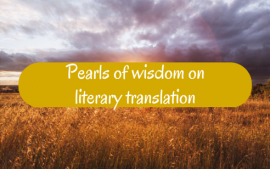
Barbara Bonatti Divers reports highlights from the Scottish Network’s summer event 2014, a seminar on translating for publication
The topics presented by our four excellent speakers were numerous and diverse, on that gorgeous summer day in Dumfries and Galloway: from the history of literary translation to how to select a suitable book to translate; from how to approach publishers to how to make sure they choose you; from the challenges posed by different genres to the relationship with authors, publishers and editors… This article just highlights the points I personally found most informative.
Our speakers
Ingrid Price-Gschlössl, MITI, AIL – On non-fiction travel literature
Lucinda Byatt, MITI, MA, PhD, Translators’ Association – On non-fiction history and art literature
Beth Fowler, MA (Hons) in Hispanic Studies – On fiction and how to get started
Kari Dickson, MA, Translators’ Association – On crime fiction
Getting your first literary translation published
Two main scenarios were discussed.
- You are asked by an agency you already work for to translate a book
- You approach publishers with a book you want to translate
Ingrid Price-Gschlössl explained the official procedure for the latter:
- Approach the author first, if still living, to seek support/approval
- Contact the original publisher’s copyright department to ask whether the rights are still available for the language in which you want to translate the book
- If the answer is “yes”, prepare a sample translation (usually a couple of chapters) as well as a summary of the book, and approach potential publishers in your target country with your proposal
- The interested foreign publisher will then purchase the rights (however this does NOT guarantee that you will be their translator of choice)
- Competition is fierce, so give the publisher an incentive to choose you. It helps to obtain a bursary (scholarship) or win a prize
- Most importantly, never give up: persevere, persevere, persevere!
Bursaries
Ingrid had a book she wanted to translate into German: Against a Peacock Sky by Monica Connell. She had never translated literature before, but she fell in love with this book in very peculiar circumstances: she had accompanied her anthropologist daughter to a development project in Nepal. At night, ten volunteers would gather in a mud hut around a single candle, in freezing temperatures, and read chapters of this book, a diary of Monica Connell’s time spent with a remote Nepalese community.
The book had struck a chord, but Ingrid knew that with no prior literary translation under her belt she would have to give publishers some confidence in her abilities. That is where the bursary came in. Being a member of BDÜ, the German interpreters’ and translators’ association, she had access to information on the many bursaries (travel, residential and financial) available to German translators. She applied for and obtained a financial bursary from the City of Vienna, equivalent to about 1,500 Euros. Not much, but enough to show publishers that her translation skills had been vetted and approved (and that her fees were partly covered already). Needless to say, she got the job, though the whole process had taken her a year. The good thing about bursaries, Ingrid reassured us, is that you normally do not need to pay them back, even if you do not get published in the end.
Kari Dickson took advantage of bursaries, too. She discovered her talent for literary translation while working in the theatre, where she was asked to translate two Ibsen plays. She was told how organizations such as the Goethe-Institut and NORLA1 offer translators bursaries of up to £2,000 (for sample translation and summary) to promote foreign literature to publishers in Britain/USA. It took her more than two years to land her first contract, and it was for a co-translation: both translators wanted the same book so badly that they proposed the joint contract to the publisher, who accepted.
Prizes
Beth Fowler’s reference for the publisher, by contrast, came in the form of the Harvill Secker Young Translators’ Prize2, which she won in 2010. Up until then she had been a commercial translator, with dreams of one day branching out into literary work. All of a sudden that day had come. Her first published book was Open Door, by Argentinian author Iosi Havilio, followed by its sequel and books by other Hispanic authors. Winning the prize had quite literally opened new doors to her!
Lucinda Byatt reminded us that non-fiction literature has its own prize, too: the FIT’s Aurora Borealis Prize3, which is partly financed by copyright revenue. However, it was actually an agency she worked for which gave Lucinda her first non-fiction literary book to translate: Piero Camporesi’s The Fear of Hell.
Uncertain about her own abilities, she consulted other translations of work by the same author for inspiration. In the end she made the difficult choice to go against the trend and not simplify the author’s complex style as other translators had done.
How to select potential publishers
- Attend as many book fairs and festivals as possible, in both target and source countries, but take it in stages: the first day can be rather overwhelming. Have a look around for publishers specializing in your particular genre. Do not try to engage in business talk just yet: mark all your possible targets in the event’s catalogue, then go home and get to work. As Ingrid put it, there is no point in contacting every publisher under the sun, just to be met by a demoralizing avalanche of refusals. Select your targets well!
- Involve the authors in your pursuit: chances are they have an international agent who looks after their promotion. Although agents do not represent translators, the author may persuade them to mention your name as their translator of choice, when marketing to your target country… Publishers do have a tendency to listen to agents more.
- Acquire the Writers & Artists Yearbook.
- Do A LOT of soft networking. Beth told us that winning a prize did help, but joining e-groups and being seen at every event, festival and International Translation Day was what really did it for her. Most of it happens in London, she admitted, but it is worth the expense: your face will start to be recognized. One day, she said (and Kari promptly agreed), a publisher will urgently need a translator and will say: “Remember that person who was ALWAYS around?”
- Join the Translators’ Association: its journal features a publisher in every issue. Unfortunately, you must already have at least one publishing contract (not necessarily published work) under your belt before you can become a member.
- Check out And Other Stories4, a grassroots publisher which runs reading groups and face-to-face discussions on foreign material (short extracts translated into English) to select possible books for translation
- Attend the International Summer School in Literary Translation5, organized by the British Centre for Literary Translation, University of East Anglia.
- Offer to write a Reader’s Report. These are poorly paid (£50-100), but a good way to get your name out there. As a member of the audience commented: she reads books all the time, so she might as well get paid to do it! Their purpose is to give the publisher the plot and “feel” of a foreign book that it is considering for publication.
Some guidelines for a good Reader’s Report:
- Do give the full plot (including twists). Do not worry about spoilers.
- Do describe the feel of the book.
- Do offer any relevant comparison with similar previously published books.
- Do not show off! This is a service you provide, not your personal showcase.
- Do include translated reviews about the book from the country of origin.
- Do offer your personal opinion and recommendations, both on the book itself and the way it would (or would not) fit in with the publisher’s genre.
- Remember! Publishers are not the enemy: they are as passionate about books as we are. And as Beth found, they are usually very generous in passing your name around, once they know you.
Workload management
Lucinda and Beth both found that literary translation on its own does not guarantee a steady workflow. They usually alternate commercial translation work with literary assignments, often running the two at the same time, for reasons of both practicality and sanity. Literary work averages 100,000 words and can take more than a year to complete, you can hardly put all other clients on hold. Equally, periodically breaking up the intensity of literary translation (particularly fiction) with something more mechanical may also prove to be an invaluable release of mental strain.
We came away energised by this lively event. Well done to the organizers, who found such interesting speakers and beautiful venue. Finally, a big thank you to the staff of the Dumfries Holiday Inn, who provided us with tablecloths to sit on, under hundred-year-old trees, when we moved outside to escape the summer heat.
Links:
1http://www.norla.no/en/information/translation_subsidy
2http://www.vintage-books.co.uk/about-us/harvill-secker/harvill_secker_young_translators_prize/
3http://www.fit-ift.org/?p=225
4http://www.andotherstories.org/
5http://www.bclt.org.uk/summer-school/
Header image credit: Unsplash
Header image edited with Canva
Reblogged with permission by the author
This article was originally published in the ITI Bulletin (November-December 2014), the bi-monthly journal of the Institute of Translation & Interpreting (www.iti.org.uk).
Author bio
Barbara Bonatti Divers MITI DPSI has been interpreting, translating and tutoring freelance since 2005. She is Italian and moved to Scotland in 1996 at the age of 31. She specialises in Environment, Tourism, Polymers and Plastics but has a passion for everything scientific and has attained ITI’s CPD Award every year since joining. You can contact her at intoitalian@bonattidivers.plus.com. Connect with her on Twitter (@BBonattiDivers) and LinkedIn www.linkedin.com/in/barbarabonattidivers.









Amazingly useful article, thanks so much for sharing! I’m bookmarking this one!